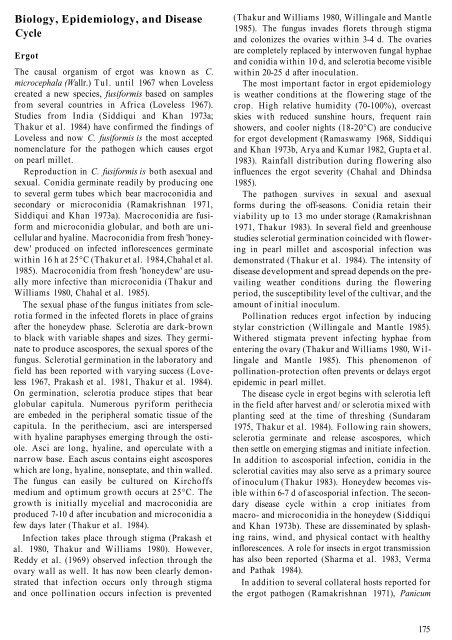RA 00110.pdf - OAR@ICRISAT
RA 00110.pdf - OAR@ICRISAT
RA 00110.pdf - OAR@ICRISAT
Create successful ePaper yourself
Turn your PDF publications into a flip-book with our unique Google optimized e-Paper software.
Biology, Epidemiology, and Disease<br />
Cycle<br />
Ergot<br />
The causal organism of ergot was known as C.<br />
microcephala (Wallr.) Tul. until 1967 when Loveless<br />
created a new species, fusiformis based on samples<br />
from several countries in Africa (Loveless 1967).<br />
Studies from India (Siddiqui and Khan 1973a;<br />
Thakur et al. 1984) have confirmed the findings of<br />
Loveless and now C. fusiformis is the most accepted<br />
nomenclature for the pathogen which causes ergot<br />
on pearl millet.<br />
Reproduction in C. fusiformis is both asexual and<br />
sexual. Conidia germinate readily by producing one<br />
to several germ tubes which bear macroconidia and<br />
secondary or microconidia (Ramakrishnan 1971,<br />
Siddiqui and Khan 1973a). Macroconidia are fusiform<br />
and microconidia globular, and both are unicellular<br />
and hyaline. Macroconidia from fresh 'honeydew'<br />
produced on infected inflorescences germinate<br />
within 16 h at 25°C (Thakur et al. 1984,Chahal et al.<br />
1985). Macroconidia from fresh 'honeydew' are usually<br />
more infective than microconidia (Thakur and<br />
Williams 1980, Chahal et al. 1985).<br />
The sexual phase of the fungus initiates from sclerotia<br />
formed in the infected florets in place of grains<br />
after the honeydew phase. Sclerotia are dark-brown<br />
to black with variable shapes and sizes. They germinate<br />
to produce ascospores, the sexual spores of the<br />
fungus. Sclerotial germination in the laboratory and<br />
field has been reported with varying success (Loveless<br />
1967, Prakash et al. 1981, Thakur et al. 1984).<br />
On germination, sclerotia produce stipes that bear<br />
globular capitula. Numerous pyriform perithecia<br />
are embeded in the peripheral somatic tissue of the<br />
capitula. In the perithecium, asci are interspersed<br />
with hyaline paraphyses emerging through the ostiole.<br />
Asci are long, hyaline, and operculate with a<br />
narrow base. Each ascus contains eight ascospores<br />
which are long, hyaline, nonseptate, and thin walled.<br />
The fungus can easily be cultured on Kirchoffs<br />
medium and optimum growth occurs at 25°C. The<br />
growth is initially mycelial and macroconidia are<br />
produced 7-10 d after incubation and microconidia a<br />
few days later (Thakur et al. 1984).<br />
Infection takes place through stigma (Prakash et<br />
al. 1980, Thakur and Williams 1980). However,<br />
Reddy et al. (1969) observed infection through the<br />
ovary wall as well. It has now been clearly demonstrated<br />
that infection occurs only through stigma<br />
and once pollination occurs infection is prevented<br />
(Thakur and Williams 1980, Willingale and Mantle<br />
1985). The fungus invades florets through stigma<br />
and colonizes the ovaries within 3-4 d. The ovaries<br />
are completely replaced by interwoven fungal hyphae<br />
and conidia within 10 d, and sclerotia become visible<br />
within 20-25 d after inoculation.<br />
The most important factor in ergot epidemiology<br />
is weather conditions at the flowering stage of the<br />
crop. High relative humidity (70-100%), overcast<br />
skies with reduced sunshine hours, frequent rain<br />
showers, and cooler nights (18-20°C) are conducive<br />
for ergot development (Ramaswamy 1968, Siddiqui<br />
and Khan 1973b, Arya and Kumar 1982, Gupta et al.<br />
1983). Rainfall distribution during flowering also<br />
influences the ergot severity (Chahal and Dhindsa<br />
1985).<br />
The pathogen survives in sexual and asexual<br />
forms during the off-seasons. Conidia retain their<br />
viability up to 13 mo under storage (Ramakrishnan<br />
1971, Thakur 1983). In several field and greenhouse<br />
studies sclerotial germination coincided with flowering<br />
in pearl millet and ascosporial infection was<br />
demonstrated (Thakur et al. 1984). The intensity of<br />
disease development and spread depends on the prevailing<br />
weather conditions during the flowering<br />
period, the susceptibility level of the cultivar, and the<br />
amount of initial inoculum.<br />
Pollination reduces ergot infection by inducing<br />
stylar constriction (Willingale and Mantle 1985).<br />
Withered stigmata prevent infecting hyphae from<br />
entering the ovary (Thakur and Williams 1980, Willingale<br />
and Mantle 1985). This phenomenon of<br />
pollination-protection often prevents or delays ergot<br />
epidemic in pearl millet.<br />
The disease cycle in ergot begins with sclerotia left<br />
in the field after harvest and/ or sclerotia mixed with<br />
planting seed at the time of threshing (Sundaram<br />
1975, Thakur et al. 1984). Following rain showers,<br />
sclerotia germinate and release ascospores, which<br />
then settle on emerging stigmas and initiate infection.<br />
In addition to ascosporial infection, conidia in the<br />
sclerotial cavities may also serve as a primary source<br />
of inoculum (Thakur 1983). Honeydew becomes visible<br />
within 6-7 d of ascosporial infection. The secondary<br />
disease cycle within a crop initiates from<br />
macro- and microconidia in the honeydew (Siddiqui<br />
and Khan 1973b). These are disseminated by splashing<br />
rains, wind, and physical contact with healthy<br />
inflorescences. A role for insects in ergot transmission<br />
has also been reported (Sharma et al. 1983, Verma<br />
and Pathak 1984).<br />
In addition to several collateral hosts reported for<br />
the ergot pathogen (Ramakrishnan 1971), Panicum<br />
175

















